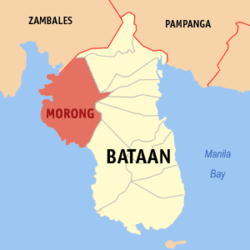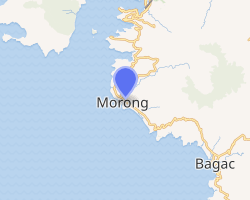Morong, Bataan
Morong, officially the Municipality of Morong (Tagalog: Bayan ng Morong; Kapampangan: Balen ning Morong), is a 3rd class municipality in the province of Bataan, Philippines. According to the 2015 census, it has a population of 29,901 people.[3]
Morong | |
|---|---|
| Municipality of Morong | |
Downtown area | |
 Seal | |
| Nickname(s): Bataan's Wild West | |
 Map of Bataan with Morong highlighted | |
OpenStreetMap 
| |
.svg.png) Morong Location within the Philippines | |
| Coordinates: 14°40′48″N 120°16′06″E | |
| Country | |
| Region | Central Luzon (Region III) |
| Province | Bataan |
| District | 1st District |
| Barangays | 5 (see Barangays) |
| Government | |
| • Type | Sangguniang Bayan |
| • Mayor | Cynthia L. Estanislao |
| • Vice Mayor | Maria Chona L. Garcia |
| • Congresswoman | Geraldine Roman |
| • Electorate | 21,107 voters (2019) |
| Area | |
| • Total | 219.20 km2 (84.63 sq mi) |
| Population (2015 census)[3] | |
| • Total | 29,901 |
| • Density | 140/km2 (350/sq mi) |
| • Households | 6,828 |
| Economy | |
| • Income class | 3rd municipal income class |
| • Poverty incidence | 15.01% (2015)[4] |
| • Revenue (₱) | 120,865,448.71 (2016) |
| Time zone | UTC+8 (PST) |
| ZIP code | 2108 |
| PSGC | |
| IDD : area code | +63 (0)47 |
| Climate type | tropical monsoon climate |
| Native languages | Mariveleño Tagalog |
The municipality is home to the Subic Bay International Airport, the Bataan Nuclear Power Plant, and the former Philippine Refugee Processing Center. Morong was formerly known as Moron.[5] It is accessible via the Bataan Provincial Expressway, off Exit 65.
History
Morong, originally called Bayandati, was a small settlement located in Barrio Nagbalayong.[6] Due to the scarcity of land available for cultivation, the early inhabitants migrated to adjacent areas where wider lands can be discovered. They found Poblacion, the present site where the Spaniards met the natives of Moron.
Folkloric tradition alludes the etymology of the name Moron to the Spaniards' mishearing of the phrase "mga Moro umurong" when they asked the local people the name of their village. The historical accuracy of this etymology is questionable, however, since early Filipinos could not have known or used the term Moro as it were the Spaniards who have started using the term to refer to Filipino Moslems, a Spanish term for the Moslem Moorish conquerors of 8th century Spain.
The most probable etymology comes from the Spanish word morón which refers to a hill which can be seen from the sea. Several towns are also named Morón namely Morón in Cuba; Morón de la Fronterra in Sevilla, Spain; and Morón in Buenos Aires, Argentina. These place all have hilly topographies and are nearby the ocean.
On June 10, 1955, Moron was renamed Morong by virtue of Republic Act No. 1249.[7]
In 1754, it became part of Corrigimento de Mariveles together with Bagac and Maragondon, Cavite.[8] But it was only in 1607 that Morong was officially founded as an ecclesiastical parish by the Augustinian Recollects[9] as well as being founded by Fr. Rodrigo de San Miguel who placed it under the protection of the Our Lady of the Pillar.[10] The Our Lady of the Pillar Parish of Morong, erected in 1607 and is now one of the oldest seats of Catholic faith in the Philippines;[11] originally orchestrated from the elements of the Gothic, Renaissance, and Baroque sources. It culminated its 400th Year foundation anniversary on October 12, 2007.[12]
World War II
Conscription of Morong Residents
During the onset of the war, able-bodied men from Morong, Bataan were called to volunteer for the army. Many residents answered the call to serve. Later after the fall of Bataan up until the Liberation, boonie guerilla groups sought to fight and sabotage the Japanese occupying forces.
The Seven Day Battle of Mauban (Morong, Bataan)
For the defense of Bataan, the main and first battle position established by the USAFFE was the Mabatang(Abucay)-Mauban(Morong) Line. General Wainwright was in command of the Mauban side of the defense.
On 16 January 1942, Imperial Japanese Army and an Allied coalition of Filipino-American forces both raced to capture Morong. Although both had arrived at approximately the same time, the allies were the first to notice the other party (the Japanese). To therefore commit a surprise attack, Lieutenant Edwin P. Ramsey of the 26th Cavalry Regiment ordered his troops to charge; the 27 heavily outnumbered Filipino and American cavalrymen charged and scattered the surprised Japanese. It was the last charge of American cavalry[13]
Geography
According to the Philippine Statistics Authority, the municipality has a land area of 219.20 square kilometres (84.63 sq mi) [2] constituting 15.97% of the 1,372.98-square-kilometre- (530.11 sq mi) total area of Bataan.
Morong is bounded by Dinalupihan to the northeast, Hermosa and Orani to the east, and province of the Zambales to the north. Olongapo City is located directly north of Morong, accessible via SBMA - Olongapo Access Road through Rizal Highway to Aguinado Road or Security Road to East 14th Street.
Climate
| Climate data for Morong, Bataan | |||||||||||||
|---|---|---|---|---|---|---|---|---|---|---|---|---|---|
| Month | Jan | Feb | Mar | Apr | May | Jun | Jul | Aug | Sep | Oct | Nov | Dec | Year |
| Average high °C (°F) | 31 (88) |
32 (90) |
34 (93) |
35 (95) |
33 (91) |
31 (88) |
29 (84) |
29 (84) |
29 (84) |
29 (84) |
30 (86) |
31 (88) |
31 (88) |
| Average low °C (°F) | 19 (66) |
19 (66) |
20 (68) |
23 (73) |
25 (77) |
25 (77) |
24 (75) |
25 (77) |
25 (77) |
24 (75) |
23 (73) |
20 (68) |
23 (73) |
| Average precipitation mm (inches) | 7 (0.3) |
8 (0.3) |
14 (0.6) |
26 (1.0) |
127 (5.0) |
210 (8.3) |
263 (10.4) |
272 (10.7) |
218 (8.6) |
114 (4.5) |
46 (1.8) |
21 (0.8) |
1,326 (52.3) |
| Average rainy days | 4.0 | 4.0 | 6.9 | 11.2 | 21.0 | 24.5 | 27.4 | 26.9 | 25.9 | 21.9 | 13.4 | 6.3 | 193.4 |
| Source: Meteoblue [14] | |||||||||||||
Barangays
Morong is politically subdivided into 5 barangays.[15]
| PSGC | Barangay | Population | ±% p.a. | |||
|---|---|---|---|---|---|---|
| 2015[3] | 2010[16] | |||||
| 030808001 | Binaritan | 20.0% | 5,966 | 5,273 | 2.38% | |
| 030808002 | Mabayo | 16.0% | 4,771 | 4,275 | 2.11% | |
| 030808003 | Nagbalayong | 20.8% | 6,207 | 5,680 | 1.70% | |
| 030808004 | Poblacion | 18.4% | 5,511 | 5,105 | 1.47% | |
| 030808005 | Sabang | 24.9% | 7,446 | 5,838 | 4.74% | |
| Total | 29,901 | 26,171 | 2.57% | |||
Environmental protection
The Pawikan Conservation Center is a community-based effort to protect turtles in Morong with a focus on protecting the Olive Ridley species.[17]
Demographics
|
| ||||||||||||||||||||||||||||||||||||||||||||||||
| Source: Philippine Statistics Authority[3][16][18][19] | |||||||||||||||||||||||||||||||||||||||||||||||||
In the 2015 census, Morong had a population of 29,901.[3] The population density was 140 inhabitants per square kilometre (360/sq mi).
Economy
Existing industries in Morong include mango/cashew production as well as vinegar making from nipa palm nuts and the production of basketry using jungle vines.[6]
There is some variety of developments intended for Morong. Industries targeted for development are the manufacturing of component parts or assembly operations. In addition, there are plans to establish convention centers, exhibit halls, golf course and clubs, entertainment and leisure and sports centers, hotels, beach resorts and meditation centers.[6]
Mining
Morong has also had some activity in mining. In 1972 it had mining activity from Long Beach Mining Corporation producing magnetite concentrate from beach sands[20] and in 2017 there was headway into opening 709.6 hectares of land to Gandara minerals and development corporation in order to mine basalt and other associated minerals.[21]
Economic Zone Developments
The Bataan Technology Park (informally called the "Technopark") is the main zone of the Morong Special Economic Zone (MSEZ), established in March 1997[22] after a previous ecozone which was established under the 1992 Bases Conversion and Development Act.[23] The park's investors can claim the following benefits:
- A 5% levy on Gross Income Earned (in lieu of all national and local taxes and duties)
- Tax and duty-free importation of raw materials and capital equipment
- Management of the zone as a separate customs territory, ensuring the free flow of movement of goods and capital equipment within, imported and exported out of the zone
- The Atmanda Ecopark also has potential as a retirement haven and a corporate training center
Popular culture
- Some scenes of the 2009–2010 ABS-CBN religious-themed teleserye May Bukas Pa were taped within the municipality, such as on a scene in its final episode where there are many children playing together, including Santino (Zaijian Jaranilla), Rico (Timothy Chan), Alfred (Miguelito de Guzman), Joy (Phoebe Khae Arbotante), and Grace (Erin Panlilio). Said scene was taped at Ilanin Forest West in Subic Bay Freeport Zone, Morong.
Gallery
- Municipal hall
- Public market
- Morong landscape
- Seascape
- Park and covered court
References
- "Municipality". Quezon City, Philippines: Department of the Interior and Local Government. Retrieved 31 May 2013.
- "Province: Bataan". PSGC Interactive. Quezon City, Philippines: Philippine Statistics Authority. Retrieved 12 November 2016.
- Census of Population (2015). "Region III (Central Luzon)". Total Population by Province, City, Municipality and Barangay. PSA. Retrieved 20 June 2016.
- "PSA releases the 2015 Municipal and City Level Poverty Estimates". Quezon City, Philippines. Retrieved 12 October 2019.
- "Republic Act No. 1249; An Act Changing the Name of the Municipality of Moron, Province of Bataan, to Morong". LawPH.com. Archived from the original on 3 May 2012. Retrieved 17 August 2020.
- "Morong – bataan.gov.ph". Retrieved 2020-03-28.
- "Republic Act No. 1249". The LawPhil Project. Retrieved 2020-03-28.
- "About – bataan.gov.ph". Retrieved 2020-03-28.
- "7 bishops, more than 60 priests expected in Morong Canonical Coronation". 1Bataan. 2018-10-10. Retrieved 2020-03-28.
- "About Morong". www.morong.gov.ph. Retrieved 2020-03-28.
- "Our Lady of the Pillar image crowned in Bataan". CBCPNews. 2018-10-10. Retrieved 2020-03-28.
- "History of Morong, Bataan". visitmorong.com. Archived from the original on 10 December 2014. Retrieved 10 December 2014.
- Steve Shaw (4 September 2008). "The Last U.S. Cavalry Charge". Parting Shot. Western Shooting Horse Magazine. Retrieved 22 October 2009.
- "Morong: Average Temperatures and Rainfall". Meteoblue. Retrieved 26 April 2020.
- "Municipal: Morong, Bataan". PSGC Interactive. Quezon City, Philippines: Philippine Statistics Authority. Retrieved 8 January 2016.
- Census of Population and Housing (2010). "Region III (Central Luzon)". Total Population by Province, City, Municipality and Barangay. NSO. Retrieved 29 June 2016.
- MORELLA, CECIL (29 February 2016). "Turtles' vulnerable start to life on Bataan coast". GMA News. Retrieved 29 March 2020.
- Censuses of Population (1903–2007). "Region III (Central Luzon)". Table 1. Population Enumerated in Various Censuses by Province/Highly Urbanized City: 1903 to 2007. NSO.
- "Province of Bataan". Municipality Population Data. Local Water Utilities Administration Research Division. Retrieved 17 December 2016.
- Morton, Rogers; Falkie, Thomas (1972). Minerals Yearbook, Volume 3. Washington D.C: UNITED STATES DEPARTMENT OF THE INTERIOR. p. 660.
- http://region3.mgb.gov.ph/mgb_roIII_files/pdf/Mining_Permits_and_Contracts/December_2017/Exploration-Permit.pdf (See Entry 29)
- "Bataan Technological Park, Inc. (BTPI) – Invest in Bataan". Retrieved 2020-03-28.
- Philippines, Doing Business, Investing in Philippines Guide. Printed: United States of America. International Business Publications. 2018. p. 56. ISBN 978-1-387-56731-7.CS1 maint: others (link)
External links

- Morong Profile at PhilAtlas.com
- Philippine Standard Geographic Code